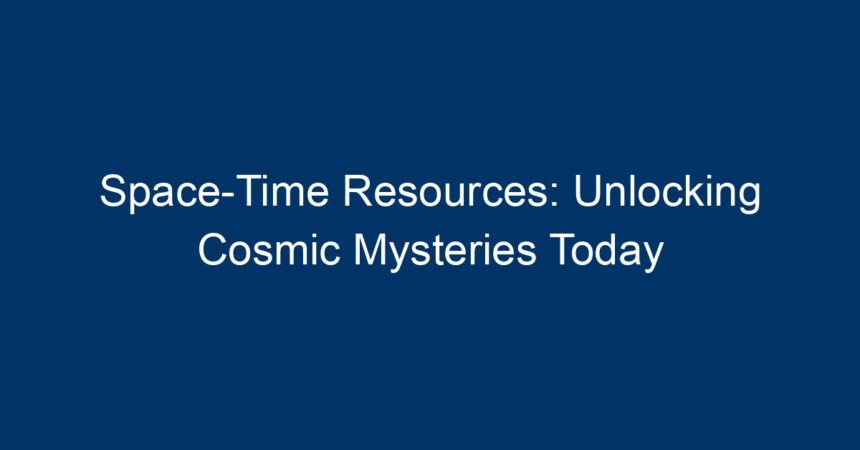In the vast expanse of the universe, few concepts fascinate humanity as much as the intricate dance of space and time. The fabric known as space-time forms the foundation of our understanding of physics, influencing everything from the orbit of galaxies to the ticking of our clocks. In this article, we will delve into the exciting world of space-time resources, exploring how scientists are unlocking cosmic mysteries that could revolutionize our understanding of the universe.
Understanding Space-Time: The Basics
What is Space-Time?
Before diving into the resources that explore space-time, it’s essential to understand what the term means. Space-time combines the three dimensions of space with the fourth dimension of time into a single interwoven continuum. Albert Einstein’s theory of relativity suggests that the structure of space and time is not independent but rather interconnected, influencing each other in profound ways.
The Role of Einstein’s Theory of Relativity
Einstein’s groundbreaking theory fundamentally transformed our perception of gravity, space, and time. It established that massive objects curve space-time, leading other objects to follow a path dictated by this curvature. This theory laid the groundwork for our exploration of space-time resources, inspiring countless scientific endeavors.
Space-Time Resources: A Scientific Treasure Trove
1. Cosmic Microwave Background Radiation (CMBR)
One of the most significant space-time resources we have is the Cosmic Microwave Background Radiation (CMBR). This faint afterglow from the Big Bang provides crucial insights into the early universe, dating back approximately 13.8 billion years. By studying CMBR, scientists can glean information about the universe’s expansion, age, and composition.
Why CMBR Matters
CMBR is a treasure trove of data, offering clues about significant cosmic events like inflation and the formation of the first atoms. Researchers utilize sophisticated telescopes, such as the Wilkinson Microwave Anisotropy Probe (WMAP) and the Planck satellite, to analyze variations in this radiation. This helps in refining models of the universe’s evolution.
2. Gravitational Waves
Another fascinating area of space-time resources comes from the detection of gravitational waves. These ripples in the fabric of space-time are created by some of the universe’s most violent events, such as merging black holes or neutron stars. LIGO (Laser Interferometer Gravitational-Wave Observatory) made history by detecting these waves for the first time in 2015.
The Implications of Gravitational Waves
The observation of gravitational waves opens up a new avenue for astronomical research, allowing scientists to investigate phenomena that were previously invisible. By analyzing these waves, researchers hope to understand the nature of black holes, neutron stars, and even the properties of the universe during its infancy.
3. Quantum Mechanics and Space-Time
Quantum mechanics also plays a crucial role in our understanding of space-time resources. The interplay between quantum particles and gravitational fields challenges conventional perceptions of reality. Concepts like entanglement and superposition introduce intriguing possibilities for how we understand time and space at the quantum level.
The Quest for a Unified Theory
Scientists are actively working toward a unified theory that integrates quantum mechanics with general relativity. This quest highlights the necessity of utilizing diverse space-time resources to bridge the gap between the macroscopic universe and the quantum realm. Projects like string theory and loop quantum gravity are at the forefront of this pursuit.
Technologies for Exploring Space-Time
1. Advanced Telescopes
Modern astronomy has been revolutionized by the development of advanced telescopes. Instruments like the James Webb Space Telescope are designed to capture detailed images of distant stars and galaxies, providing new insights into the structure of space-time.
2. Numerical Simulations
Numerical simulations allow scientists to model complex systems, from galaxy formation to cosmic events. By using high-performance computing, researchers can virtually experiment with space-time phenomena, predicting outcomes and refining theoretical models.
3. Particle Accelerators
Facilities such as the Large Hadron Collider (LHC) create conditions similar to the early universe, allowing scientists to study fundamental particles and forces at play in space-time. Discoveries at the LHC contribute to our understanding of the universe’s building blocks, informing theories related to space-time.
Navigating Ethical Questions in Space-Time Research
As we unlock cosmic mysteries through space-time resources, ethical considerations come to the forefront. The potential applications of this knowledge, from advanced technologies to space exploration, raise questions about how we should proceed responsibly.
Balancing Innovation with Responsibility
Scientists and policymakers must collaborate to ensure that advancements in understanding space-time are utilized for the greater good. This involves contemplating the implications of discovering new forms of energy, potential for space colonization, and the impact on our understanding of reality.
The Future of Space-Time Exploration
As technology progresses, the future of space-time exploration holds exciting possibilities. New tools and methodologies are being developed to push the boundaries of our understanding, fostering collaboration among scientists worldwide.
Emerging Trends
-
Interdisciplinary Collaboration: The merging of fields such as astrophysics, quantum mechanics, and computer science will yield innovative solutions and fresh approaches to exploring space-time resources.
-
Artificial Intelligence: AI and machine learning algorithms will play vital roles in analyzing vast datasets from telescopes and simulations, enabling faster discoveries and deeper insights.
- Public Engagement: Utilizing platforms to engage the public can inspire the next generation of scientists. Citizen science projects encourage participation in space-time research, democratizing scientific discovery.
Actionable Insights
How You Can Contribute to Space-Time Research
-
Stay Informed: Keep updated on the latest discoveries in astrophysics and space-time research through reputable science journals and websites.
-
Get Involved: Participate in outreach programs or citizen science initiatives focused on space exploration.
- Support STEM Education: Advocate for and support educational initiatives that encourage young minds to explore science, technology, engineering, and mathematics (STEM).
Embracing the Cosmic Journey
Understanding space-time resources offers profound insights not just about the universe but also about our place within it. As we unravel these cosmic mysteries, we invite others to join in the exploration, fostering a collective journey toward discovery.
Conclusion
Space-time resources provide an essential gateway into the mysteries of the cosmos. Through the study of phenomena like CMBR, gravitational waves, and advancements in quantum mechanics, humanity is on the brink of a new era in understanding the universe. As we harness these resources, a collaborative and ethical approach will be paramount, ensuring that our quest for knowledge expands horizons and propels us into a brighter, more informed future.
The cosmic mysteries await—are you ready to explore?




